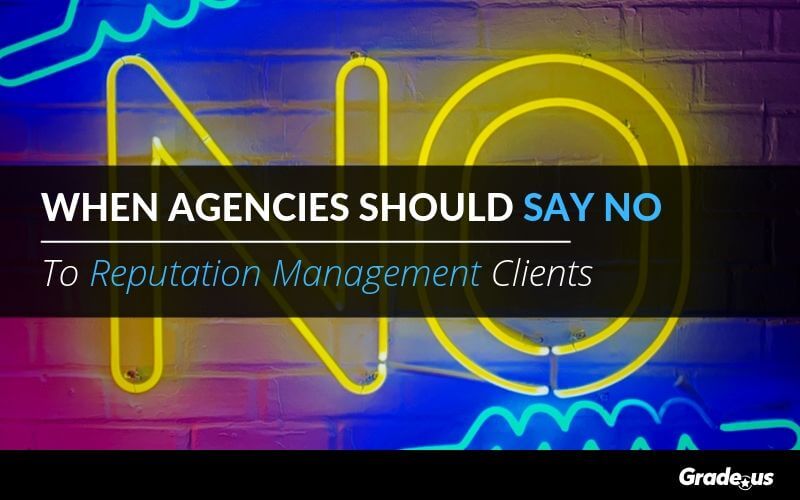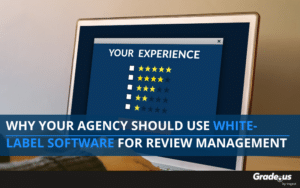Updated: 10/14/2019
When you’re building your marketing agency, every time you bring on a new client, it’s like adding someone to your family.
It’s tempting to accept anyone.
It's especially tempting when you’re just starting out or beginning to look for reputation management clients. Worse yet, we often talk with new agencies who reason that businesses with the worst reputations must be the best candidates for reputation management. Hint: they aren’t.
But there’s more to it.
Choosing the wrong reputation management clients to work with can be disastrous for your business, potentially costing you money, time, and your reputation. Here’s what you'll need to consider before taking a client on:
- You’ll need to know your own business and your own ideal customer.
- How you identify your ideal Reputation Management clients.
- Red flags that will allow you to avoid the wrong types of clients.
- How and why you should say No when you establish that a client is not the right match.
These details are important because they act as protective mechanisms. This is also why it's important to iron these details ahead of time. When you have a framework in place, your agency can efficiently attract, convert or screen prospective clients.
Knowing Your Agency, Your Audience, and Your Niche
Many of you already have a target audience in mind or in practice, but for marketers who are just starting up your agency, take heed: it’s rarely a good idea to try and be everything to everyone.
We understand this first-hand.
Grade.us might seem like a different animal because we’re a SaaS company, right? The reality is that we’ve periodically had to reevaluate our own target customers.
In 2017, that meant discontinuing a Basic plan. This plan was originally designed to serve small and local businesses with an affordable review and reputation management software they could buy directly. Over the years, we found that serving single location small business customers alongside marketers, agencies, and SEOs was bifurcating our efforts and preventing us from serving either group optimally.
We were forced to make a tough decision.
By eliminating our Basic plan and focusing on our Professional, Agency, and Partner plans, we were able to focus our attention on one core customer segment. This decision-making meant we were able to grow more swiftly within that target market, and ultimately increase our profitability by achieving greater scale with less support demand. Plus, Small Business owners can still use our Professional plan, but the higher price point works as a gatekeeper for those who are less sophisticated or not ready to truly commit to their reputation management efforts.
When it comes to your target audience, focus your attention on these key factors:
Key Factors
LOCATION
Are you only working with reputation management clients locally, or are you willing to work with clients no matter regardless of their business location?
INDUSTRY
Are you a generalist, or do you have a few specific industries that you prefer to work with?
BUSINESS SIZE
Will you work with individual entrepreneurs, small 1-5 employee businesses, medium-sized companies, or enterprises?
CLIENT’S DEMOGRAPHIC
Do you prefer to work with B2C clients or B2B clients? Would you prefer working with clients that serve a younger audience or an older audience?
BUDGET
Are you only working with clients that have a larger budget, or are you amenable to work with smaller organizations that are bootstrapping?
PERSONALITY
Is your ideal client’s personality more fun and adventurous when it comes to marketing or more conservatively professional and risk-averse?
Once you’ve identified your target, you’ll be able to tailor your services and marketing services, address them as potential reputation management clients with your marketing/sales funnel, lead scoring, etc.
Who is the Ideal Reputation Management Client?
When it comes to identifying ideal current or prospective reputation management clients, you might look for the following sensibilities:
- They invest in customer experience. Customer support is a top priority. These reputation management clients are responsive in social media, have a strong internal culture, and make customers feel like they’re the number one priority (you’d be surprised how many companies don’t embody this mindset).
- They already have a positive online reputation. They have a spattering of positive reviews on a few different review sites. They have already garnered press affirming the value of their product or service.
- They view you as an expert in your field and respect your recommendations and execution.
- They have reasonable expectations for communication when working with you.
- Your main contact has the authority to make actionable decisions for the company. That contact also understands the value you provide, respects your time, and buys into the importance of your services.
Researching Your Prospects
How are you able to know if your prospect checks all of these ideal client boxes?
Start by doing your research. First, plug their business into our online reviews report tool and generate a report to scout their existing online reputation (or get your own branded version of the tool from us).
Conduct your research:
- Investigate their website and social media channels.
- Scour their site to see what sort of customer support they’re offering. Is there an easy to find support form or email address? Do they have a phone number on the site?
- Take it to the next level and call in as a prospect to see what it’s like to talk to someone at the company. How did they make you feel when they spoke with you?
- Read their ‘About us’ page to get a sense of their company persona and mission statement.
- See how active they are on social media channels and how they utilize them to interact with customers. Are they consistent? Are they providing value to their audience?
- Go on LinkedIn and take a look at the employees of the company. Do they have great recommendations and endorsements?
Doing this upfront work is absolutely crucial. If prospective clients are a good fit for your agency, the specificity and details gleaned in your research will help you to land the sale. On the other hand, if you notice several red flags, this specificity will help you to turn clients away without burning bridges.
Keep Your Eyes Open for Red Flags
You already know what to look for in ideal reputation management clients, but what are those red flags that should make you double-take?
Ben Butler, former head of communications at Do It Inbound, now Zen Pilot, writes about five illustrative personas in an article aptly titled, "5 Clients Who Will Burn Your Agency Down." These archetypes apply equally well to reputation management clients. In short, here they are:
- Cheapskates. Don’t compromise the integrity of your pricing by accommodating them. Doing so devalues your services, and these folks always require more hand-holding and support. The worst thing about these cheapskates is the fact that they refer more cheapskates to your business. Drop your price once and they’ll never let you raise them again.
- Scatter-brains. When working with small businesses, your main point of contact will undoubtedly have multiple responsibilities outside of your relationship. You don’t need their constant, undivided attention, but you do need to be able to get it once in a while.
- Disinterested Parties. As mentioned when discussing the ideal candidate, you need the higher-ups to understand and buy-in to the value that you’re providing and value customer service. These are the “just take care of it” clients who can’t be bothered to stay engaged in the process. They’re also the same clients who show up angry at the end, disappointed that they haven’t received the results they were promised.
- Egomaniacs. This type of person tends to think they know everything and will have a hard time respecting your expertise. Naturally, you’ll have to cater to them. And you can imagine how quickly they’ll get upset with you when their own demands aren’t producing results.
- Over-eager Beavers. When it comes to reputation management, earning positive reviews is an ongoing, long-term process. It takes time. Set expectations accordingly, and if the client has no appreciation for reality, look for the door.
A few additional problem clients to add to that list would be:
- Clients with Shiny-object syndrome. These are the clients who are full of ideas but unwilling or unable to commit to any one idea for a reasonable amount of time. They abandon your strategies or work in favor of the next best thing.
- Self-absorbed clients who believe anything and everything that happens is about them. These clients are a drain on your team and your agency’s morale. They’ll expect special favors, resist boundaries you’ve sent and use tantrums to get their way.
- Poor managers. These are the clients who can’t seem to remember anything you’ve shared with them. They’re constantly asking you to resend content, instructions or data. Any tasks you assign them will remain unfinished. They’re flakey and unreliable, complicating your ability to get things done. What’s worse, they’ll still blame you if your reputation management campaign fails to achieve results.
- Users and takers. These clients are cousins to the cheapskates Butler mentions above. These are the clients who deserve the negative attention they’ve received. Here’s how they work. When they show up, they appear to be the perfect clients. They’re engaged in the process, pay on time and willing to work hard. It’s all a ruse. These clients are interested in one thing. Squeeze as much free work out of you before they skip out on your bill.
- Client mercenaries. These clients don’t want to partner with their agency. They’re looking for vendors. They treat their agencies and contractors like disposable help. They edit or change your work to suit their purposes; they do what they want. They’ll ignore your recommendations in favor of your own. They’ll put you through decision-by-committee, a grueling process where multiple decision-makers and influencers shred your work if it boosts their social capital. Doing wants best for the organization is the last thing on their mind.
This sounds great and all, but it doesn't really explain how you ferret out these behaviors ahead of time. That's the problem here, isn't it? It's the fact that clients need to be embedded in your business first before you're able to spot these red flags?
Not at all.
There's a simple strategy you can use to get these clients to out themselves. It's a strategy agencies should already be using. Most aren't using this strategy, which is part of the reason why their client selection tactics are so poor.
Act as if they're already a client.
This behavior means you're behaving as if prospects are already your client before you've completed the sales process. Doing this gets clients to lower their defenses. What does this look like?
1. You're using humble inquiry to identify your prospect's desires, goals, fears, frustrations and problems.
2. Prospects immediately receive attentive help from you on their most pressing issues. At this point, you're unconcerned about money. You're simply working to provide value.
3. Instead of telling prospects what you can do, you show them by acting immediately, providing them with the beginnings of an outstanding solution.
4. With your performance fresh in your prospect's mind, you ask for the sale.
5. You treat the agreements and payment as a formality, a foregone conclusion. Your prospects already have a relationship with you. Their agreement and payment is simply a way for them to ratify what both of you already know.
Here's why this works.
Your behavior requires a significant amount of trust. Am I asking you to serve your prospect, for free, with no guarantee of return? Absolutely, it's something most agencies, most people won't do. Most are looking for a sure thing. When you act as if your prospect is already a client, something incredible happens.
Prospects show you who they really are.
The very same prospect who was unwilling to share their budget, may now volunteer their budget and ask you if it's enough. When prospects see that you're not concerned about separating them from their money, it changes the game.
Prospects lose their leverage.
At that point, the givers, takers and matchers reveal themselves. The scatterbrained, the egomaniacs and the self-absorbed - all of them will expose themselves when you bring them through the process. All you have to do is accept those who best fit what you're looking for.
What about the prospects you don't want?
That's simple, isn't it? You say, "No thanks." In reality, it's not so simple. Act aggressively, behave inappropriately and you may have earned yourself an enemy. Why is it so important to choose your words carefully when you decide to reject a prospect?
Your prospects aren't used to it. It's an exceedingly rare phenomenon for a business to reject their clients. When it happens, it really hurts.
How To Say "No"
If it becomes pretty clear that you and the prospect aren’t a proper fit, how you let them down can actually impact your business.
Naomi Dunford of ittybiz explains:
"Saying no to a potential client is an especially weird animal because it is often very difficult for people to imagine anybody turning down paid work."
She provides a thoughtful email template for how to say no in her article.
Adam Grant, Wharton professor and author of Give and Take, recommends several tactics you can use to say No to reputation management prospects who aren't a fit:
- The deferral. “I’m completely swamped right now. Would you be willing to follow up with me in (three months)?”
- The delay. “This isn’t usually the kind of campaign we take on; to do this right I’d need (XYZ).”
- The introduction. I believe I can help, but I’m completely swamped right now. I could provide you with an introduction to (professional). Would you be interested?”
- The bridge. “I’m not sure I have what it takes to handle this campaign. When it comes to (problem) in (industry), two agencies come to mind. Would you like me to arrange a sit down for you?”
- The relational account. “If I take your campaign on, there may be a (conflict of interest). I’d be letting several of our best clients down. I’m so sorry.”
Both Dunford and Grant point out how delicate of a process saying "No" needs to be. The last thing you want to do is burn bridges. They both recommend providing a recommendation or solution to the client if their services aren’t the right fit. By providing that value, the prospect may end up referring their network back to you if they are a better fit for your agency.
As a general rule of thumb, provide value to everyone in some capacity, even if you’re not being contracted. You never know how those people can come back to help you in the future.
Saying no to reputation management clients is difficult
You’re turning away business. But the truth is, the cost of a bad fit in terms of time, energy, personality styles and resources, will impact your agency’s bottom line.
By rejecting these opportunities, you’re setting your agency up for happier clients, more realistic results, and a more enjoyable agency-client relationship. Chances are, you’ll also begin to see more referrals for the right people.
It’s tempting to accept anyone.
The more intense your temptation, the more important it is to resist that temptation.
The truth of the matter here is this: Your agency isn't right for everyone. Some clients just aren't a good fit for your business.
These important self-protective mechanisms enable savvy agencies to attract, convert, or screen prospective clients at scale.
About the Author
Garrett Sussman
Garrett is the Head of Marketing at Grade.us, an online review management and marketing platform. When he's not crafting content, he's scouting the perfect ice coffee, devouring the newest graphic novels, and concocting a new recipe in the kitchen.









